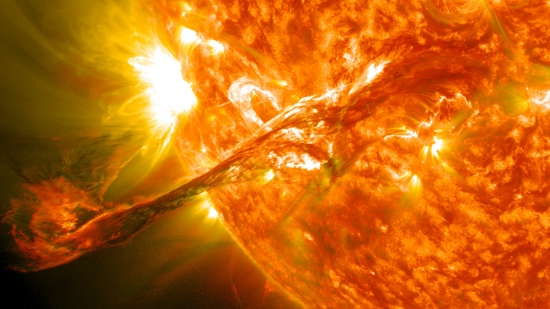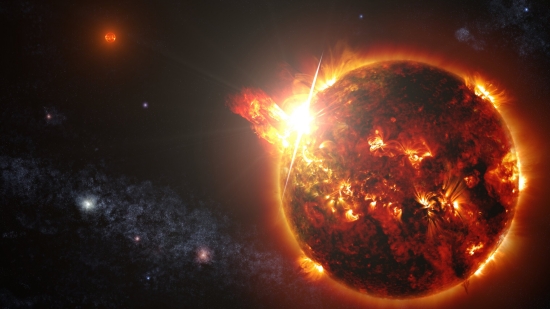The interesting transient associated with Proxima Centauri and monitored by Breakthrough Listen reminds us of a key fact about red dwarf stars and the planets around them. Such stars, especially in their youth, are prone to high flare activity, meaning violent, unpredictable emissions that can deplete atmospheric gases like ozone. Even if the atmosphere survives strong stellar winds, the loss of ozone can lead to high levels of ultraviolet radiation reaching the surface and compromising any life there.
That stellar flares can be dramatic is captured in the image below, showing a filament eruption from the Sun and accompanying solar flares (credit: NASA/GSFC/SDO). As striking as the image is, it depicts activity on an older star less prone to strong flare activity than younger, smaller stars. We’re also fortunate in having the shield offered by Earth’s magnetic field, which can deflect the worst of the solar wind. Our G-class Sun lets us orbit at a comfortable distance, but planets in the habitable zones of M-class dwarfs are in tight orbits. Proxima Centauri b, for example, orbits its primary in a scant 11 days at a distance of 0.0485 AU.

This may or may not be a deal-breaker for life, given evolutionary change that may force adaptations we can only imagine, but it certainly creates stark conditions for its formation. Even so, such activity may also provide us with opportunities when it comes to observing biosignatures. This morning I learned about a study from Northwestern University that takes a close look at stellar flares and the evolution of planetary atmospheres. We learn that flare activity can create atmospheric changes that actually make certain biosignatures more detectable.
Northwestern’s Howard Chen is lead author on the study:
“We compared the atmospheric chemistry of planets experiencing frequent flares with planets experiencing no flares. The long-term atmospheric chemistry is very different. Continuous flares actually drive a planet’s atmospheric composition into a new chemical equilibrium.”
What the Northwestern team has done is to combine a suite of three-dimensional coupled chemistry-climate model simulations with observed flare activity from a variety of stars. The scientists examined planet scenarios with varying rotation period, magnetic field strength and flare frequency, showing that recurring flares drive the atmospheres of planets around both K- and M-class stars “into chemical equilibria that substantially deviate from their pre-flare regimes, whereas the atmospheres of G dwarf planets quickly return to their baseline states.”
We should be able to use this fact to our advantage. Flares may help us see otherwise undetectable atmospheric components like nitrogen dioxide, nitrous oxide and nitric acid, which the paper describes as “bio-indicating chemical species.” Nearby red dwarfs, already useful because of their transit depth (a big planet passing in front of a small star is readily seen) now offer new ways to hunt biosignatures as next-generation space telescopes come online.
The study examines planets within the habitable zones of M- and K-class stars, where the habitable zones are smaller and the stellar activity more frequent. Tidally locked planets in this setting, with one face turned toward their star at all times, may lack the magnetic fields needed to deflect their stellar winds. The researchers used flare data from TESS, NASA’s Transiting Exoplanet Survey Satellite, in adjusting their simulations. From the paper:
For all scenarios, we find that flaring produces the largest magnitude alteration in nitrous oxide (N2O), a biosignature… Both HNO3 and H2Ov mixing ratios are enhanced on average by two to three orders of magnitude and the enhancements are maintained with repeated flaring in the K- and M-star planet scenarios… In contrast, CH4 experiences stronger removal via reaction with ion-derived OH during flaring, leading to lower temporal-mean CH4 mixing ratios (not shown). These results suggest that although biosignatures such as CH4 are vulnerable to destruction during periods of strong flaring, bio-indicating ‘beacon of life’ species could be prominently highlighted.

Image: An artistic rendering of a series of powerful stellar flares. Credit: NASA’s Goddard Space Flight Center/S. Wiessinger.
Published in Nature Astronomy, the research includes contributions from researchers at the University of Colorado at Boulder, the University of Chicago, Massachusetts Institute of Technology and NASA’s Nexus for Exoplanet System Science (NExSS).
Notice that we are increasingly studying exoplanet atmospheres in relation to space weather in the host star’s vicinity. Understanding how the signatures of chemical components vary with stellar activity like coronal mass ejections and flares — and in particular what the observational consequences may be — will help us shape the observing campaigns of future instruments, with consequences for detecting biosignatures.
The paper is Chen et al., “Persistence of flare-driven atmospheric chemistry on rocky habitable zone worlds,” Nature Astronomy 21 December 2020 (abstract).



I don’t know quite how to read this paper. The argument seems to be that some biosignature gases are INCREASED (by abiotic chemistry) due to the flare-induced atmospheric changes, while others are reduced. Does this mean that these stars can create ambiguous biosignatures, or that they make it easier to detect biosignature gases to refine instruments before targeting more favorable planets for life? Any idea of whether phosphine would be increased by these flares?
Boy, is this an interesting paper if you have a Chemistry background. The results are not unexpected as lightening is the main source of Nitrogen Oxides on Earth.
I have some questions for Paul:
In the abstract, they talk about O2 poor and O2 rich atmospheres. What is their definition of an O2 poor atm?
Did they indicate what H2Ov was? I haven’t come across that term.
When they talk about the mixing ratios of HNO3 and H2Ov, this implies they are both gaseous species. Were they talking about these as gases?
Thanks
Dave
Dave, yes re HNO3 and H20v as gases, but I tripped on H20v as well. Let me send you something back channel; meanwhile, will try to clarify re H2Ov.
H2Ov = water as a vapor, rather than as a liquid.
Learn something every day! Thanks, Alex. That was new to me.
Ah, I’m used to my phase indicators have parenthesis around them. A letter directly attached indicates to me a variable number as in NOx.
I gave this paper a read and got the following things from it:
But first I must note that my interest in the paper is somewhat tangental to the authors’ intent. The authors were interested in finding out what sort of spectra the would see when they pointed their telescopes at a planet and what this would indicate about its atmospheric chemistry. I was interested in how the atmospheric chemistry would affect the habitability and possibility of life on the planet.
Anyhow: 1) Flares remove ozone through the formation of Nitrogen Oxides and hydroxyl ions. The oxygen can come from disassociated water vapor.
2) Flares can also induce atmospheric loss.
3) Nitrogen Oxides in the upper atmosphere = smog. Tidally locked planets have poor circulation between their upper and lower atmospheres = lots of smog. (Artist in future may need to include a brown, hazy sky in their illustrations.)
4) The highly reactive hydroxyl ions remove methane and other reduced species such as dimethyl Sulphide giving the impression the planet is more oxidized than it is.
5) The upper atmosphere Nitrogen Oxide concentrations in planets around M-dwarf stars go from one part in 10 to the 8 to one part in 10 to the 6, so while this doesn’t radically change the atmosphere, it has the effect of showering the surface and oceans below with Nitrogen fertilizer, somewhat like we are doing to Earth now.
I have a couple of thoughts on this:
I don’t think a lake of Ozone layer is inimical to life. A few feet of ocean absorb it, and while UVC kills microscopic life quickly, macroscopic life could quite easily develop shielding.
While Nitrates and other Nitrogen Oxide compounds make good oxidants for life (Many bacteria use them recycling Nitrogen into the atmosphere.), I’m a little worried that some of the reducing compounds necessary for the formation of life would be destroyed by the Nitrogen Oxides produced by a flair-ridden primeval atmosphere.
How well would a Nitrogen Oxide smog layer shield the surface of such a world from UV?
One other aspect of flaring, that may be relevant to the development of life is that if flaring is strong enough to produce significant atmospheric stripping. Then the most likely life bearing planets around M-dwarf class stars are super Earths which initially have a thick enough atmosphere to tolerate stripping. The thinned atmosphere might even be more conducive to life (as we know it) and may even push mini-Neptunes into the super Earth category.
I would agree. I’d also like to point out that Red Dwarfs spend a long time descending their Hayashi tracks, so a habitable planet is going to be spending 100s of millions to a billion years with a steam atmosphere before cooling enough for it to condense out. If Earth were in such a state, it would have 350 bar of steam to about 1 bar of Nitrogen. If the atmosphere strips proportionately, most of what you are going to loose is water vapor.
I never did puzzle out where they modelled the post-flare hydrogen in compounds was coming from. They mentioned something about methane, but I wasn’t clear if that was a significant source. Or maybe the water simply evaporates and rises?
The effect is particularly interesting if UV from flares really does suppress surface life forms on these exoplanets. If such life forms are restricted to the dark side, then their energy source is limited either to long-distance transmission of heat that is subsequently radiated to space (‘anti-solar cells’, thermoradiative power – I don’t think nyctoautotrophy is a word yet!) or chemoautotrophy. Such drastic changes to the atmosphere suggest the latter could be more important than we might have guessed.
The Lithosphere of the planet would, like Earth’s, be mildly reducing producing Hydrogen through Serpentinization. This in turn would mean that its volcanoes would emit reducing compounds.
A lack of an ozone layer may make a planet a lot less habitable to humans, but I don’t see it being an impediment to life. When it comes to UVC, a foot of water is a sufficient shield, and while microscopic life may have a hard time on the land surface, macroscopic life could easily develop compounds that absorb UVC. They are just discovering that various animal species glow in the dark after been exposed to UV. This is caused by proteins that absorb UV and reradiate it as light.